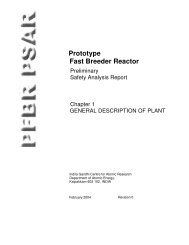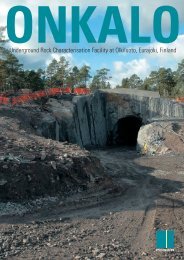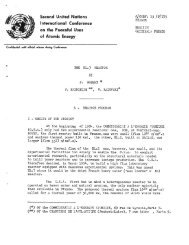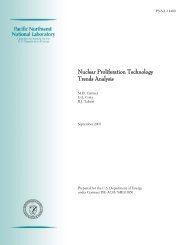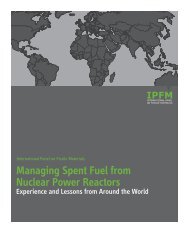Research Report No - International Panel on Fissile Materials
Research Report No - International Panel on Fissile Materials
Research Report No - International Panel on Fissile Materials
You also want an ePaper? Increase the reach of your titles
YUMPU automatically turns print PDFs into web optimized ePapers that Google loves.
Under the terms of the deal, India’s CIRUS reactor will be shut down in 2010, by which<br />
time it could yield another 45 kg of weap<strong>on</strong> grade plut<strong>on</strong>ium, while the Dhruva reactor<br />
will c<strong>on</strong>tinue to operate and to add about 20-25kg/year. There are plans to c<strong>on</strong>struct a<br />
new unsafeguarded reactor that can produce at least as much plut<strong>on</strong>ium as Dhruva.<br />
India has also kept the Prototype Fast Breeder Reactor (PFBR) out of safeguards arguing<br />
that “Both from the point of view of maintaining l<strong>on</strong>g term energy security and for<br />
maintaining the minimum credible deterrent the Fast Breeder Programme just cannot be<br />
put <strong>on</strong> the civilian list.” We have estimated that this reactor, to be completed in 2010,<br />
could produce up to 130 kg of weap<strong>on</strong> grade plut<strong>on</strong>ium each year; this four-fold increase<br />
in India’s current producti<strong>on</strong> would amount to another 25 nuclear weap<strong>on</strong>s a year.<br />
India has proposed that between now and 2014 it will declare eight of its sixteen power<br />
reactors as civilian and open them for IAEA safeguarding. We estimate that these eight<br />
reactors could yield another four t<strong>on</strong>s of unsafeguarded plut<strong>on</strong>ium before they are opened<br />
for inspecti<strong>on</strong>. The remaining eight power reactors are to be unsafeguarded, ‘military’<br />
facilities. They could add 1250 kg per year of reactor-grade plut<strong>on</strong>ium.<br />
In recent years, India’s nuclear complex has been c<strong>on</strong>strained by access to uranium. We<br />
estimate that India’s current uranium producti<strong>on</strong> of less than 300 t<strong>on</strong>s/year can meet at<br />
most, two-thirds of its needs for civil and military nuclear fuel. It has had to rely <strong>on</strong><br />
stocks of previously mined and processed uranium to meet the shortfall and is now trying<br />
to increase producti<strong>on</strong>. Under the deal, India will be able to import uranium for<br />
safeguarded reactors and we estimate this may give it a ‘surplus’ of 70-120 t<strong>on</strong>s a year of<br />
domestic uranium that it can use, if it so chose, in its weap<strong>on</strong>s program. By expanding its<br />
practice of recycling depleted uranium (c<strong>on</strong>taining 0.61% uranium-235) from CIRUS and<br />
Dhruva in its unsafeguarded power reactors, India could increase this ‘surplus.’ We<br />
estimate that this could allow India to produce up to 200 kg a year of weap<strong>on</strong> grade<br />
plut<strong>on</strong>ium in its ‘military’ power reactors, provided that it can overcome the associated<br />
practical problems of increased rates of spent fuel reprocessing and faster refueling of<br />
power reactors.<br />
Pakistan’s Nati<strong>on</strong>al Command Authority (NCA), chaired by President Pervez Musharraf,<br />
has declared that “In view of the fact the [U.S.-India] agreement would enable India to<br />
produce a significant quantity of fissile material and nuclear weap<strong>on</strong>s from<br />
unsafeguarded nuclear reactors, the NCA expressed firm resolve that our credible<br />
minimum deterrence requirements will be met.” This suggests that an expansi<strong>on</strong> of fissile<br />
material stockpiles in South Asia may ensue, even though it would be at odds with the<br />
policies of “minimum deterrence” announced by both India and Pakistan. Both states<br />
already far exceed the fissile material requirements for a ‘minimal’ nuclear arsenal.<br />
Rather than pursue the opti<strong>on</strong> of a large expansi<strong>on</strong> of their nuclear arsenals, they should<br />
choose to suspend all further producti<strong>on</strong> of fissile materials for weap<strong>on</strong>s purposes,<br />
pending the negotiati<strong>on</strong> and entry into force of a <strong>Fissile</strong> Material Cut-off Treaty.<br />
4



